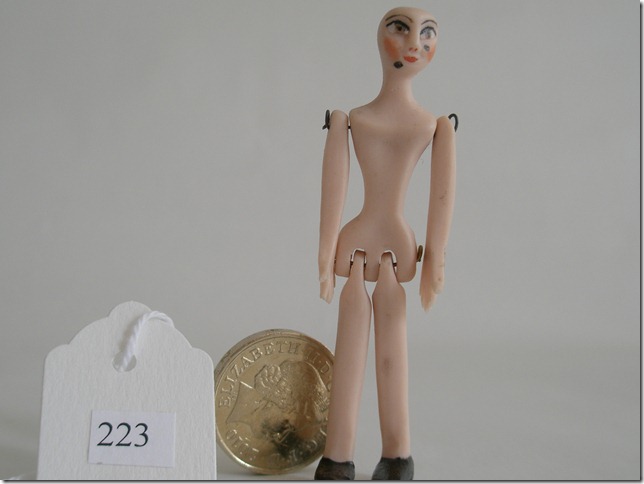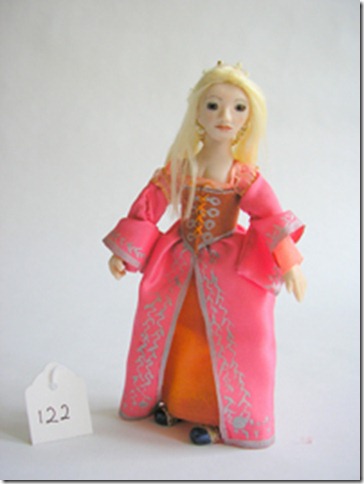Sorry if this posting is a bit late. I’ve had some sort of viral infection, one of those involving many unhappy hours in the bathroom. On the minus side I’ve lost some weight, on the other minus side I had to have a day off yesterday, on the plus side, I should have lots of antibodies to see me through the summer. This probably much too much information, back to the miniatures.
I’m enjoying doing the fireplaces very much, though I’m only managing one a day. Here are the sculpts so far: 
Left to right they are: Edwardian, late 18th/early 19th coal burning range, Victorian/Greek revival, late mediaeval log burner ingle with bread oven, early mediaeval with huge smoke hood, art deco.
One of the interesting features of revisiting dolls’ houses in a different scale is discovering how much history I already know.
At school I enjoyed history; one year we had a brilliant book about domestic arrangements in the last thousand years, with exploded diagrams of dwellings, starting with a Norman castle, that now I look back on it, were definitely dolls’ houses. As a child I spent many hours in antique shops, looking very thoroughly, in the way children look.
So when I acquired my Edwardian house and wanted to know what should go in each room and why, I found I had a good foundation in place. I soon knew exactly why every artefact in every room had the right to be there. Then I did my 16th scale cardboard house (it was a very cheap kit devised by a chap who had come by a large amount of cut-price cardboard) and placed it in the 1930s and wanted to know about life before the war, which was childhood for the generation before me. Then I got on to Queen Mary’s dolls’ house and was into the inter-war period. I think I may have started on dolls by this time and was certainly learning costume history along with the social history and also the jewellery that went with the costumes because, before dolls, I made jewellery.
Then I started on my own build, the Board School at Carlton Miniott and researched the history of education, which I had visited briefly in teacher training. As it was a Victorian school, I also researched the Victorians and found I already knew quite a lot from antiquing days. Any Victorian artefact could safely be given to a curious child to play with in my youth, because they were worth so little. Back then nothing was regarded as antique unless it was at least a hundred years old.
I slightly bypassed the 18th century, partly because the houses were so expensive, partly because I’ve always felt I might have been alive then anyway and partly because I was then starting to make dolls and got totally carried away by my first sculpt, the very glorious Madame de Pompadour. So for a while I came over all French and lived at the court of the Sun king.
This was a brief phase, however, because by then I was comparing the things I read in history books with each other and starting to spot discrepancies. So I began researching from period writings and started with Sam Pepys. I fell in love with him easily and started collecting for a 24th scale house I was going to make out of a file box. I still have all the bits. The doll of Mr Pepys, in the style of a doll of the time, has just gone into the sale category.
I still have my head in the 17th century because I never finished the 12th scale house I then built from a kit, though I did buy the stuff two shows ago to finish the roof.
Then Shakespeare in Love hurled me back a century and there I was, revisiting an era I’d already researched to help my son build his 16th century 24th scale room, which is where I learned all about ingle fireplaces and timber framed buildings.
A couple of the Shakespeare dolls were so good they never left home. After that I started devouring general history books and discovered Christopher Hibbert, a prolific writer of more than 50 books, all wonderfully researched. Sadly Christopher belongs to history himself now.
In a flash I was back with another old friend:
When that Aprille with her schowers swoote……….
Geoffrey, who I first met at O level and shortly afterwards won a book prize encompassing him. At this point, ten years ago, I stopped and wrote a historic novel (which still has to find a publisher) encompassing the history of the town I live in back to Ethelfleda, daughter of Alfred the Great, who founded it. I then began to evolve some theories of history myself, in regard to the Dark Ages, which I don’t think were, at all.
Having gone back in time, in detail, 1200 years, I still didn’t think of myself as being good at history, despite being able to date things that turn up on the Antiques Roadshow quite easily, until I started doing the fireplaces.
I got some books out of the library to research styles but I find I only need them for the detail of modelling. I know what should be in houses of most dates, in Britain, for the past thousand years. It’s quite amazing to find it’s all there in my head. I have very thoroughly learned history by making dolls’ houses, up to and including the ones I only made in my head.
There is absolutely no educational experience in the history department quite as comprehensive as making a miniature house and discovering how to build it, what to put in it and why. Everything is covered from the way the window frames are recessed because of government laws following fires such as the Great fire of London, to the sewing samplers made by children that qualified them to make their own clothes.
Human history is in a dolls’ house, I can’t think why building one is not in the national curriculum of countries round the world.
Back to the fireplaces. I cannot decide whether to have a go at the sort of 17th century grand effort that Sam Pepys complained so bitterly of visitors relieving themselves in overnight (the same they were cooking on later, having meat that was burned in parts and raw elsewhere – they must have had antibodies for everything.) Or shall I do a smaller combined cottage range and fire? I recall doing charity visits with my mother to coal miner’s widows, who had free coal that was kept burning permanently in small black combination ranges. Or if anyone is doing a Wren inspired house, what about a bit of English baroque?
It’s very exciting, history, and even more exciting to know you know enough to give you lots of choices. The thing I don’t know is to what era your 48th scale house belongs. I’ve got a fairly good idea because of the styles that are available but if there’s one thing that I have most definitely learned it is that miniaturists are very inventive history buffs. So, before I move off fireplaces and into the bathroom, if there’s something you want, speak up!
~~~~~~~~~~~~~~~~~~~~~~~~~~~~~~~~~~~~~~~~~~~~~~~~~~
JaneLaverick.com – history, buffed.


